#aws s3 object storage
Explore tagged Tumblr posts
Text
Amazon Simple Storage Service Tutorial | AWS S3 Bucket Explained with Example for Cloud Developer
Full Video Link https://youtube.com/shorts/7xbakEXjvHQ Hi, a new #video on #aws #simplestorageservice #s3bucket #cloudstorage is published on #codeonedigest #youtube channel. @java #java #awscloud @awscloud #aws @AWSCloudIndia #Cloud #
Amazon Simple Storage Service (Amazon S3) is an object storage service that offers industry-leading scalability, data availability, security, and performance. Customers of all sizes and industries can use Amazon S3 to store and protect any amount of data. Amazon S3 provides management features so that you can optimize, organize, and configure access to your data to meet your specific business,…
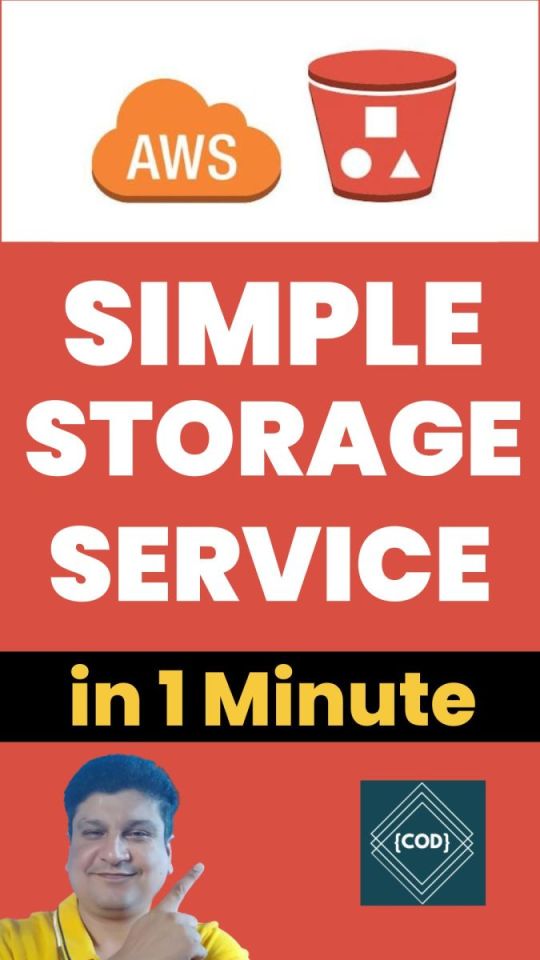
View On WordPress
#amazon s3#amazon s3 bucket#amazon s3 tutorial#amazon web services#aws#aws cloud#aws s3#aws s3 bucket#aws s3 bucket tutorial#aws s3 interview questions and answers#aws s3 object lock#aws s3 object lock governance mode#aws s3 object storage#aws s3 tutorial#aws storage services#cloud computing#s3 bucket#s3 bucket creation#s3 bucket in aws#s3 bucket policy#s3 bucket public access#s3 bucket tutorial#simple storage service (s3)
0 notes
Text
0 notes
Text
Deep Dive into Protecting AWS EC2, RDS Instances and VPC
Veeam Backup for Amazon Web Services (Veeam Backup for AWS or VBAWS) protects and facilitates disaster recovery for Amazon Elastic Compute Cloud (EC2), Amazon Relational Database Service (RDS), Amazon DynamoDB, and Amazon Elastic File System (EFS) environments. In this article, we shall deep dive into Protecting AWS EC2 and RDS Instances and VPC (Amazon Virtual Private Cloud) configurations as…
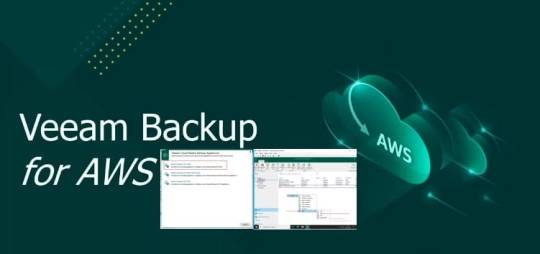
View On WordPress
#Amazon S3 Object Storage#AWS RDS Backups with Veeam#Database Backups#Protecting AWS EC2 and RDS#RDS Automated Backup#Veeam#Veeam Backup and Replication#Veeam Backup for AWS
0 notes
Video
youtube
Complete Hands-On Guide: Upload, Download, and Delete Files in Amazon S3 Using EC2 IAM Roles
Are you looking for a secure and efficient way to manage files in Amazon S3 using an EC2 instance? This step-by-step tutorial will teach you how to upload, download, and delete files in Amazon S3 using IAM roles for secure access. Say goodbye to hardcoding AWS credentials and embrace best practices for security and scalability.
What You'll Learn in This Video:
1. Understanding IAM Roles for EC2: - What are IAM roles? - Why should you use IAM roles instead of hardcoding access keys? - How to create and attach an IAM role with S3 permissions to your EC2 instance.
2. Configuring the EC2 Instance for S3 Access: - Launching an EC2 instance and attaching the IAM role. - Setting up the AWS CLI on your EC2 instance.
3. Uploading Files to S3: - Step-by-step commands to upload files to an S3 bucket. - Use cases for uploading files, such as backups or log storage.
4. Downloading Files from S3: - Retrieving objects stored in your S3 bucket using AWS CLI. - How to test and verify successful downloads.
5. Deleting Files in S3: - Securely deleting files from an S3 bucket. - Use cases like removing outdated logs or freeing up storage.
6. Best Practices for S3 Operations: - Using least privilege policies in IAM roles. - Encrypting files in transit and at rest. - Monitoring and logging using AWS CloudTrail and S3 access logs.
Why IAM Roles Are Essential for S3 Operations: - Secure Access: IAM roles provide temporary credentials, eliminating the risk of hardcoding secrets in your scripts. - Automation-Friendly: Simplify file operations for DevOps workflows and automation scripts. - Centralized Management: Control and modify permissions from a single IAM role without touching your instance.
Real-World Applications of This Tutorial: - Automating log uploads from EC2 to S3 for centralized storage. - Downloading data files or software packages hosted in S3 for application use. - Removing outdated or unnecessary files to optimize your S3 bucket storage.
AWS Services and Tools Covered in This Tutorial: - Amazon S3: Scalable object storage for uploading, downloading, and deleting files. - Amazon EC2: Virtual servers in the cloud for running scripts and applications. - AWS IAM Roles: Secure and temporary permissions for accessing S3. - AWS CLI: Command-line tool for managing AWS services.
Hands-On Process: 1. Step 1: Create an S3 Bucket - Navigate to the S3 console and create a new bucket with a unique name. - Configure bucket permissions for private or public access as needed.
2. Step 2: Configure IAM Role - Create an IAM role with an S3 access policy. - Attach the role to your EC2 instance to avoid hardcoding credentials.
3. Step 3: Launch and Connect to an EC2 Instance - Launch an EC2 instance with the IAM role attached. - Connect to the instance using SSH.
4. Step 4: Install AWS CLI and Configure - Install AWS CLI on the EC2 instance if not pre-installed. - Verify access by running `aws s3 ls` to list available buckets.
5. Step 5: Perform File Operations - Upload files: Use `aws s3 cp` to upload a file from EC2 to S3. - Download files: Use `aws s3 cp` to download files from S3 to EC2. - Delete files: Use `aws s3 rm` to delete a file from the S3 bucket.
6. Step 6: Cleanup - Delete test files and terminate resources to avoid unnecessary charges.
Why Watch This Video? This tutorial is designed for AWS beginners and cloud engineers who want to master secure file management in the AWS cloud. Whether you're automating tasks, integrating EC2 and S3, or simply learning the basics, this guide has everything you need to get started.
Don’t forget to like, share, and subscribe to the channel for more AWS hands-on guides, cloud engineering tips, and DevOps tutorials.
#youtube#aws iamiam role awsawsaws permissionaws iam rolesaws cloudaws s3identity & access managementaws iam policyDownloadand Delete Files in Amazon#IAMrole#AWS#cloudolus#S3#EC2
2 notes
·
View notes
Text
Exploring the Power of Amazon Web Services: Top AWS Services You Need to Know
In the ever-evolving realm of cloud computing, Amazon Web Services (AWS) has established itself as an undeniable force to be reckoned with. AWS's vast and diverse array of services has positioned it as a dominant player, catering to the evolving needs of businesses, startups, and individuals worldwide. Its popularity transcends boundaries, making it the preferred choice for a myriad of use cases, from startups launching their first web applications to established enterprises managing complex networks of services. This blog embarks on an exploratory journey into the boundless world of AWS, delving deep into some of its most sought-after and pivotal services.

As the digital landscape continues to expand, understanding these AWS services and their significance is pivotal, whether you're a seasoned cloud expert or someone taking the first steps in your cloud computing journey. Join us as we delve into the intricate web of AWS's top services and discover how they can shape the future of your cloud computing endeavors. From cloud novices to seasoned professionals, the AWS ecosystem holds the keys to innovation and transformation.
Amazon EC2 (Elastic Compute Cloud): The Foundation of Scalability At the core of AWS's capabilities is Amazon EC2, the Elastic Compute Cloud. EC2 provides resizable compute capacity in the cloud, allowing you to run virtual servers, commonly referred to as instances. These instances serve as the foundation for a multitude of AWS solutions, offering the scalability and flexibility required to meet diverse application and workload demands. Whether you're a startup launching your first web application or an enterprise managing a complex network of services, EC2 ensures that you have the computational resources you need, precisely when you need them.
Amazon S3 (Simple Storage Service): Secure, Scalable, and Cost-Effective Data Storage When it comes to storing and retrieving data, Amazon S3, the Simple Storage Service, stands as an indispensable tool in the AWS arsenal. S3 offers a scalable and highly durable object storage service that is designed for data security and cost-effectiveness. This service is the choice of businesses and individuals for storing a wide range of data, including media files, backups, and data archives. Its flexibility and reliability make it a prime choice for safeguarding your digital assets and ensuring they are readily accessible.
Amazon RDS (Relational Database Service): Streamlined Database Management Database management can be a complex task, but AWS simplifies it with Amazon RDS, the Relational Database Service. RDS automates many common database management tasks, including patching, backups, and scaling. It supports multiple database engines, including popular options like MySQL, PostgreSQL, and SQL Server. This service allows you to focus on your application while AWS handles the underlying database infrastructure. Whether you're building a content management system, an e-commerce platform, or a mobile app, RDS streamlines your database operations.
AWS Lambda: The Era of Serverless Computing Serverless computing has transformed the way applications are built and deployed, and AWS Lambda is at the forefront of this revolution. Lambda is a serverless compute service that enables you to run code without the need for server provisioning or management. It's the perfect solution for building serverless applications, microservices, and automating tasks. The unique pricing model ensures that you pay only for the compute time your code actually uses. This service empowers developers to focus on coding, knowing that AWS will handle the operational complexities behind the scenes.
Amazon DynamoDB: Low Latency, High Scalability NoSQL Database Amazon DynamoDB is a managed NoSQL database service that stands out for its low latency and exceptional scalability. It's a popular choice for applications with variable workloads, such as gaming platforms, IoT solutions, and real-time data processing systems. DynamoDB automatically scales to meet the demands of your applications, ensuring consistent, single-digit millisecond latency at any scale. Whether you're managing user profiles, session data, or real-time analytics, DynamoDB is designed to meet your performance needs.
Amazon VPC (Virtual Private Cloud): Tailored Networking for Security and Control Security and control over your cloud resources are paramount, and Amazon VPC (Virtual Private Cloud) empowers you to create isolated networks within the AWS cloud. This isolation enhances security and control, allowing you to define your network topology, configure routing, and manage access. VPC is the go-to solution for businesses and individuals who require a network environment that mirrors the security and control of traditional on-premises data centers.
Amazon SNS (Simple Notification Service): Seamless Communication Across Channels Effective communication is a cornerstone of modern applications, and Amazon SNS (Simple Notification Service) is designed to facilitate seamless communication across various channels. This fully managed messaging service enables you to send notifications to a distributed set of recipients, whether through email, SMS, or mobile devices. SNS is an essential component of applications that require real-time updates and notifications to keep users informed and engaged.
Amazon SQS (Simple Queue Service): Decoupling for Scalable Applications Decoupling components of a cloud application is crucial for scalability, and Amazon SQS (Simple Queue Service) is a fully managed message queuing service designed for this purpose. It ensures reliable and scalable communication between different parts of your application, helping you create systems that can handle varying workloads efficiently. SQS is a valuable tool for building robust, distributed applications that can adapt to changes in demand.
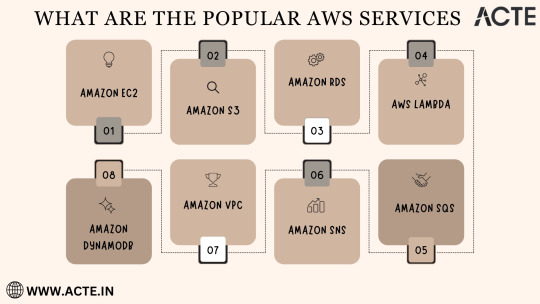
In the rapidly evolving landscape of cloud computing, Amazon Web Services (AWS) stands as a colossus, offering a diverse array of services that address the ever-evolving needs of businesses, startups, and individuals alike. AWS's popularity transcends industry boundaries, making it the go-to choice for a wide range of use cases, from startups launching their inaugural web applications to established enterprises managing intricate networks of services.
To unlock the full potential of these AWS services, gaining comprehensive knowledge and hands-on experience is key. ACTE Technologies, a renowned training provider, offers specialized AWS training programs designed to provide practical skills and in-depth understanding. These programs equip you with the tools needed to navigate and excel in the dynamic world of cloud computing.
With AWS services at your disposal, the possibilities are endless, and innovation knows no bounds. Join the ever-growing community of cloud professionals and enthusiasts, and empower yourself to shape the future of the digital landscape. ACTE Technologies is your trusted guide on this journey, providing the knowledge and support needed to thrive in the world of AWS and cloud computing.
8 notes
·
View notes
Text
Navigating the Cloud Landscape: Unleashing Amazon Web Services (AWS) Potential
In the ever-evolving tech landscape, businesses are in a constant quest for innovation, scalability, and operational optimization. Enter Amazon Web Services (AWS), a robust cloud computing juggernaut offering a versatile suite of services tailored to diverse business requirements. This blog explores the myriad applications of AWS across various sectors, providing a transformative journey through the cloud.
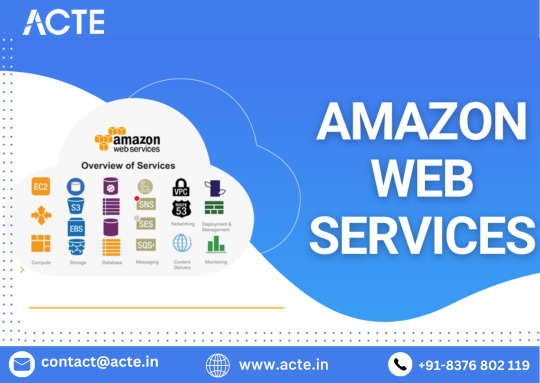
Harnessing Computational Agility with Amazon EC2
Central to the AWS ecosystem is Amazon EC2 (Elastic Compute Cloud), a pivotal player reshaping the cloud computing paradigm. Offering scalable virtual servers, EC2 empowers users to seamlessly run applications and manage computing resources. This adaptability enables businesses to dynamically adjust computational capacity, ensuring optimal performance and cost-effectiveness.
Redefining Storage Solutions
AWS addresses the critical need for scalable and secure storage through services such as Amazon S3 (Simple Storage Service) and Amazon EBS (Elastic Block Store). S3 acts as a dependable object storage solution for data backup, archiving, and content distribution. Meanwhile, EBS provides persistent block-level storage designed for EC2 instances, guaranteeing data integrity and accessibility.
Streamlined Database Management: Amazon RDS and DynamoDB
Database management undergoes a transformation with Amazon RDS, simplifying the setup, operation, and scaling of relational databases. Be it MySQL, PostgreSQL, or SQL Server, RDS provides a frictionless environment for managing diverse database workloads. For enthusiasts of NoSQL, Amazon DynamoDB steps in as a swift and flexible solution for document and key-value data storage.
Networking Mastery: Amazon VPC and Route 53
AWS empowers users to construct a virtual sanctuary for their resources through Amazon VPC (Virtual Private Cloud). This virtual network facilitates the launch of AWS resources within a user-defined space, enhancing security and control. Simultaneously, Amazon Route 53, a scalable DNS web service, ensures seamless routing of end-user requests to globally distributed endpoints.
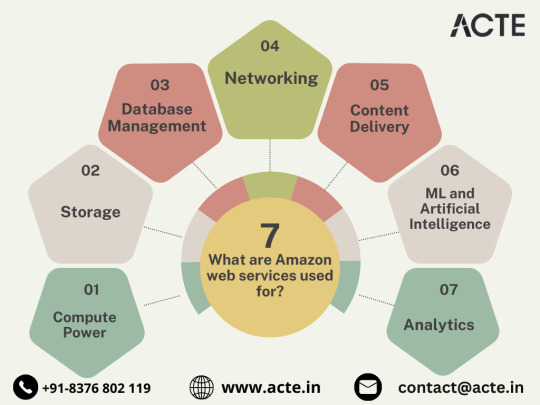
Global Content Delivery Excellence with Amazon CloudFront
Amazon CloudFront emerges as a dynamic content delivery network (CDN) service, securely delivering data, videos, applications, and APIs on a global scale. This ensures low latency and high transfer speeds, elevating user experiences across diverse geographical locations.
AI and ML Prowess Unleashed
AWS propels businesses into the future with advanced machine learning and artificial intelligence services. Amazon SageMaker, a fully managed service, enables developers to rapidly build, train, and deploy machine learning models. Additionally, Amazon Rekognition provides sophisticated image and video analysis, supporting applications in facial recognition, object detection, and content moderation.
Big Data Mastery: Amazon Redshift and Athena
For organizations grappling with massive datasets, AWS offers Amazon Redshift, a fully managed data warehouse service. It facilitates the execution of complex queries on large datasets, empowering informed decision-making. Simultaneously, Amazon Athena allows users to analyze data in Amazon S3 using standard SQL queries, unlocking invaluable insights.
In conclusion, Amazon Web Services (AWS) stands as an all-encompassing cloud computing platform, empowering businesses to innovate, scale, and optimize operations. From adaptable compute power and secure storage solutions to cutting-edge AI and ML capabilities, AWS serves as a robust foundation for organizations navigating the digital frontier. Embrace the limitless potential of cloud computing with AWS – where innovation knows no bounds.
3 notes
·
View notes
Text
Exploring AWS Cloud Services: A Key Player in Seattle’s Tech Landscape
Amazon Web Services (AWS) is a global leader in cloud computing, providing scalable and reliable cloud infrastructure to businesses of all sizes.
Headquartered in Seattle, AWS offers a suite of cloud services that enable organizations to innovate faster, reduce IT costs, and scale efficiently.
This blog will explore the importance of AWS Cloud Services, particularly in Seattle, a city that has become a hub for tech innovation and enterprise growth, with an emphasis on AWS Cloud Consulting Services in Seattle.
What are AWS Cloud Services?
AWS provides a vast array of cloud solutions, ranging from computing power and storage to machine learning and artificial intelligence.
These services are designed to support a variety of business needs, from startups to large enterprises. Some of the core AWS services include Amazon EC2 (for scalable computing), Amazon S3 (for object storage), and AWS Lambda (for serverless computing).
AWS’s global infrastructure, including its extensive network of data centers, ensures that services are delivered with high availability and low latency.
AWS Cloud Services in Seattle
Seattle, the home of Amazon, plays a pivotal role in the global cloud computing industry, and AWS Cloud Services in Seattle are central to the city's booming tech ecosystem.
From small startups to large enterprises, businesses in Seattle are increasingly relying on AWS’s flexible, secure, and cost-effective solutions. With services like AWS Elastic Beanstalk, Amazon RDS, and Amazon SageMaker for machine learning, local companies are able to scale quickly and innovate faster than ever before.
AWS Cloud Consulting Services in Seattle
For businesses in Seattle, AWS Cloud Consulting Services are invaluable. These services help organizations plan, migrate, and optimize their cloud infrastructure, ensuring they get the most out of their AWS investment.
Local AWS consultants are experts in navigating the complexities of cloud adoption, from architecture design to cost optimization.
Whether a business is transitioning to the cloud or looking to optimize an existing AWS setup, AWS consulting services can guide them through best practices and help minimize risks.
Seattle’s thriving tech community is home to numerous AWS-certified consultants and consulting firms that offer personalized solutions tailored to specific business needs.
Companies like KPMG, Slalom Consulting, and many specialized AWS partners are well-positioned to assist businesses in Seattle with cloud strategies, security assessments, and performance optimization on AWS.
The Future of AWS in Seattle
As AWS continues to expand its services and infrastructure globally, Seattle remains at the heart of this transformation.
With local data centers and a robust tech talent pool, the city is well-positioned to be a leader in cloud innovation. Startups and enterprises alike are increasingly turning to AWS to enhance their digital transformation journeys.
The presence of AWS Cloud Consulting Services in Seattle ensures that businesses have access to the expertise needed to fully leverage the power of the cloud, making Seattle a key hub for AWS adoption and growth.
Conclusion
AWS Cloud Services, including AWS Cloud Consulting Services in Seattle, are more than just technological advantages—they represent a fundamental shift in how businesses operate and scale.
Whether you're a startup seeking guidance on cloud adoption or an established enterprise looking to optimize your AWS setup, leveraging AWS’s vast offerings and local consulting expertise can help unlock new opportunities and drive innovation in today’s competitive market.
1 note
·
View note
Text
How does cloud computing enable faster business scaling for me
Cloud Computing Market was valued at USD 605.3 billion in 2023 and is expected to reach USD 2619.2 billion by 2032, growing at a CAGR of 17.7% from 2024-2032.
Cloud Computing Market is witnessing unprecedented growth as businesses across sectors rapidly adopt digital infrastructure to boost agility, scalability, and cost-efficiency. From small startups to global enterprises, organizations are shifting workloads to the cloud to enhance productivity, improve collaboration, and ensure business continuity.
U.S. Market Leads Cloud Innovation with Expanding Enterprise Adoption
Cloud Computing Market continues to expand as emerging technologies such as AI, machine learning, and edge computing become more integrated into enterprise strategies. With increased reliance on hybrid and multi-cloud environments, providers are innovating faster to deliver seamless, secure, and flexible solutions.
Get Sample Copy of This Report: https://www.snsinsider.com/sample-request/2779
Market Keyplayers:
Amazon Web Services (AWS) (EC2, S3)
Microsoft (Azure Virtual Machines, Azure Storage)
Google Cloud (Google Compute Engine, Google Kubernetes Engine)
IBM (IBM Cloud Private, IBM Cloud Kubernetes Service)
Oracle (Oracle Cloud Infrastructure, Oracle Autonomous Database)
Alibaba Cloud (Elastic Compute Service, Object Storage Service)
Salesforce (Salesforce Sales Cloud, Salesforce Service Cloud)
SAP (SAP HANA Enterprise Cloud, SAP Business Technology Platform)
VMware (VMware vCloud, VMware Cloud on AWS)
Rackspace (Rackspace Cloud Servers, Rackspace Cloud Files)
Dell Technologies (VMware Cloud Foundation, Virtustream Enterprise Cloud)
Hewlett Packard Enterprise (HPE) (HPE GreenLake, HPE Helion)
Tencent Cloud (Tencent Cloud Compute, Tencent Cloud Object Storage)
Adobe (Adobe Creative Cloud, Adobe Document Cloud)
Red Hat (OpenShift, Red Hat Cloud Infrastructure)
Cisco Systems (Cisco Webex Cloud, Cisco Intersight)
Fujitsu (Fujitsu Cloud Service K5, Fujitsu Cloud IaaS Trusted Public S5)
Huawei (Huawei Cloud ECS, Huawei Cloud OBS)
Workday (Workday Human Capital Management, Workday Financial Management)
Market Analysis
The global cloud computing landscape is being redefined by increasing demand for on-demand IT services, software-as-a-service (SaaS) platforms, and data-intensive workloads. In the U.S., cloud adoption is accelerating due to widespread digital transformation initiatives and investments in advanced technologies. Europe is also experiencing significant growth, driven by data sovereignty concerns and regulatory frameworks like GDPR, which are encouraging localized cloud infrastructure development.
Market Trends
Surge in hybrid and multi-cloud deployments
Integration of AI and ML for intelligent workload management
Growth of edge computing reducing latency in critical applications
Expansion of industry-specific cloud solutions (e.g., healthcare, finance)
Emphasis on cybersecurity and compliance-ready infrastructure
Rise of serverless computing for agile development and scalability
Sustainability focus driving adoption of green data centers
Market Scope
Cloud computing's scope spans nearly every industry, supporting digital-first strategies, automation, and real-time analytics. Organizations are leveraging cloud platforms not just for storage, but as a foundation for innovation, resilience, and global expansion.
On-demand infrastructure scaling for startups and enterprises
Support for remote workforces with secure virtual environments
Cross-border collaboration powered by cloud-native tools
Cloud-based disaster recovery solutions
AI-as-a-Service and Data-as-a-Service models gaining traction
Regulatory-compliant cloud hosting driving European market growth
Forecast Outlook
The future of the Cloud Computing Market is driven by relentless demand for agile digital infrastructure. As cloud-native technologies become standard in enterprise IT strategies, both U.S. and European markets are expected to play pivotal roles. Advanced cloud security, integrated data services, and sustainability-focused infrastructure will be at the forefront of upcoming innovations. Strategic alliances between cloud providers and industry players will further fuel momentum, especially in AI, 5G, and IoT-powered environments.
Access Complete Report: https://www.snsinsider.com/reports/cloud-computing-market-2779
Conclusion
As the digital economy accelerates, the Cloud Computing Market stands at the core of modern enterprise transformation. It empowers businesses with the tools to scale intelligently, respond to market shifts rapidly, and innovate without limits. For leaders across the U.S. and Europe, embracing cloud technology is no longer optional—it's the strategic engine driving competitive advantage and sustainable growth.
Related Reports:
U.S.A drives innovation as Data Monetization Market gains momentum
U.S.A Wealth Management Platform Market Poised for Strategic Digital Transformation
U.S.A Trade Management Software Market Sees Surge Amid Cross-Border Trade Expansion
About Us:
SNS Insider is one of the leading market research and consulting agencies that dominates the market research industry globally. Our company's aim is to give clients the knowledge they require in order to function in changing circumstances. In order to give you current, accurate market data, consumer insights, and opinions so that you can make decisions with confidence, we employ a variety of techniques, including surveys, video talks, and focus groups around the world.
Contact Us:
Jagney Dave - Vice President of Client Engagement
Phone: +1-315 636 4242 (US) | +44- 20 3290 5010 (UK)
Mail us: [email protected]
0 notes
Text
Amazon S3 - Giải pháp lưu trữ dữ liệu tối ưu cho doanh nghiệp hiện đại
Trong thời đại công nghệ số bùng nổ như hiện nay, việc quản lý và lưu trữ dữ liệu trở thành yếu tố sống còn của mọi doanh nghiệp. Từ các startup nhỏ cho đến những t��p đoàn toàn cầu, việc sử dụng một hệ thống lưu trữ an toàn, linh hoạt và có khả năng mở rộng là điều bắt buộc. Một trong những giải pháp được ưa chuộng nhất hiện nay chính là Amazon S3 – dịch vụ lưu trữ đối tượng thuộc Amazon Web Services (AWS).
S3 là gì?
Amazon S3 (Simple Storage Service) là một dịch vụ lưu trữ đám mây được phát triển bởi Amazon. Được giới thiệu lần đầu vào năm 2006, S3 cho phép người dùng lưu trữ và truy cập dữ liệu ở mọi nơi trên thế giới thông qua internet. Dữ liệu được lưu trữ dưới dạng các "object" trong các "bucket", với khả năng mở rộng không giới hạn.
Không giống như các dịch vụ lưu trữ truyền thống, S3 không chỉ là một kho lưu trữ đơn thuần mà còn tích hợp hàng loạt tính năng như phân quyền truy cập, phiên bản hóa dữ liệu, phân tích log, và đặc biệt là khả năng tích hợp với các dịch vụ khác của AWS như EC2, Lambda, CloudFront,...
Ưu điểm nổi bật của Amazon S3
Khả năng mở rộng linh hoạt
Amazon S3 cho phép bạn lưu trữ từ vài byte đến hàng petabyte dữ liệu mà không cần lo lắng về việc mở rộng cơ sở hạ tầng. Với hệ thống phân tán toàn cầu của AWS, dữ liệu của bạn luôn sẵn sàng và có thể truy cập với độ trễ thấp.
Tính bảo mật cao
Amazon S3 cung cấp các tính năng bảo mật nâng cao như mã hóa dữ liệu khi lưu trữ và trong quá trình truyền tải. Ngoài ra, bạn có thể thiết lập quyền truy cập chi tiết cho từng object hoặc bucket, giúp kiểm soát chặt chẽ ai được phép truy cập vào dữ liệu của bạn.
Độ bền và độ sẵn sàng cực cao
Amazon cam kết độ bền dữ liệu lên tới 99,999999999% (11 số 9), nghĩa là gần như không có khả năng mất mát dữ liệu. Điều này đạt được thông qua việc tự động sao lưu dữ liệu tại nhiều trung tâm dữ liệu khác nhau trên toàn cầu.
Chi phí hợp lý
S3 sử dụng mô hình tính phí theo mức sử dụng thực tế (pay-as-you-go). Người dùng chỉ trả tiền cho dung lượng lưu trữ, băng thông sử dụng và các yêu cầu truy xuất dữ liệu. Ngoài ra, Amazon S3 còn cung cấp nhiều lớp lưu trữ như S3 Standard, S3 Intelligent-Tiering, S3 Glacier,… để tối ưu chi phí theo từng nhu cầu cụ thể.
Dễ dàng tích hợp
S3 có thể tích hợp với hầu hết các ứng dụng và nền tảng công nghệ hiện đại thông qua API RESTful, SDK và AWS CLI. Điều này giúp cho các nhà phát triển dễ dàng kết nối và thao tác với dữ liệu trong S3 một cách hiệu quả.
Các trường hợp sử dụng phổ biến của Amazon S3
Lưu trữ dữ liệu website
Nhiều doanh nghiệp sử dụng S3 như một nơi lưu trữ các tài nguyên tĩnh của website như hình ảnh, CSS, JavaScript… Nhờ khả năng tích hợp với CloudFront (CDN), các tài nguyên này có thể được phân phối toàn cầu với tốc độ cao.
Sao lưu và phục hồi dữ liệu
S3 là giải pháp tuyệt vời cho việc sao lưu dữ liệu từ các hệ thống nội bộ hoặc server. Khi xảy ra sự cố, dữ liệu có thể được phục hồi nhanh chóng từ S3.
Lưu trữ và phân tích Big Data
S3 thường được sử dụng làm nơi lưu trữ dữ liệu đầu vào cho các hệ thống xử lý Big Data như Amazon Athena, Amazon Redshift hay AWS Glue. Với khả năng xử lý song song và tích hợp mạnh mẽ, S3 trở thành trung tâm dữ liệu trong hầu hết các hệ thống phân tích hiện đại.
Lưu trữ nội dung đa phương tiện
Các công ty truyền thông, video hoặc âm nhạc sử dụng Amazon S3 để lưu trữ và phân phối nội dung đa phương tiện đến người dùng trên toàn thế giới, với khả năng truyền tải ổn định và bảo mật cao.
Làm thế nào để bắt đầu với Amazon S3?
Để sử dụng S3, bạn chỉ cần một tài khoản AWS. Sau đó:
Đăng nhập vào AWS Management Console.
Tạo một "bucket" – đây là không gian chứa dữ liệu của bạn.
Tải dữ liệu (object) lên bucket.
Cấu hình quyền truy cập, chính sách bảo mật và chọn lớp lưu trữ phù hợp.
Việc quản lý bucket và object có thể thực hiện dễ dàng qua giao diện web, dòng lệnh (AWS CLI), hoặc các SDK dành cho ngôn ngữ lập trình như Python, JavaScript, Java,...
Kết luận
Amazon S3 là một trong những dịch vụ lưu trữ đám mây mạnh mẽ, linh hoạt và an toàn nhất hiện nay. Không chỉ phù hợp với các doanh nghiệp lớn, S3 còn là lựa chọn lý tưởng cho cá nhân, startup và các nhà phát triển mong muốn một nền tảng lưu trữ dữ liệu đáng tin cậy, tiết kiệm chi phí và dễ dàng tích hợp. Với sự phát triển không ngừng của công nghệ, việc sử dụng các giải pháp như S3 không chỉ là một xu hướng mà đã trở thành tiêu chuẩn trong việc xây dựng hệ thống công nghệ thông tin hiện đại.
Tìm hiểu thêm: https://vndata.vn/cloud-s3-object-storage-vietnam/
0 notes
Text
Integrating ROSA Applications with AWS Services (CS221)
In today's rapidly evolving cloud-native landscape, enterprises are looking for scalable, secure, and fully managed Kubernetes solutions that work seamlessly with existing cloud infrastructure. Red Hat OpenShift Service on AWS (ROSA) meets that demand by combining the power of Red Hat OpenShift with the scalability and flexibility of Amazon Web Services (AWS).
In this blog post, we’ll explore how you can integrate ROSA-based applications with key AWS services, unlocking a powerful hybrid architecture that enhances your applications' capabilities.
📌 What is ROSA?
ROSA (Red Hat OpenShift Service on AWS) is a managed OpenShift offering jointly developed and supported by Red Hat and AWS. It allows you to run containerized applications using OpenShift while taking full advantage of AWS services such as storage, databases, analytics, and identity management.
🔗 Why Integrate ROSA with AWS Services?
Integrating ROSA with native AWS services enables:
Seamless access to AWS resources (like RDS, S3, DynamoDB)
Improved scalability and availability
Cost-effective hybrid application architecture
Enhanced observability and monitoring
Secure IAM-based access control using AWS IAM Roles for Service Accounts (IRSA)
🛠️ Key Integration Scenarios
1. Storage Integration with Amazon S3 and EFS
Applications deployed on ROSA can use AWS storage services for persistent and object storage needs.
Use Case: A web app storing images to S3.
How: Use OpenShift’s CSI drivers to mount EFS or access S3 through SDKs or CLI.
yaml
Copy
Edit
apiVersion: v1
kind: PersistentVolumeClaim
metadata:
name: efs-pvc
spec:
accessModes:
- ReadWriteMany
storageClassName: efs-sc
resources:
requests:
storage: 5Gi
2. Database Integration with Amazon RDS
You can offload your relational database requirements to managed RDS instances.
Use Case: Deploying a Spring Boot app with PostgreSQL on RDS.
How: Store DB credentials in Kubernetes secrets and use RDS endpoint in your app’s config.
env
Copy
Edit
SPRING_DATASOURCE_URL=jdbc:postgresql://<rds-endpoint>:5432/mydb
3. Authentication with AWS IAM + OIDC
ROSA supports IAM Roles for Service Accounts (IRSA), enabling fine-grained permissions for workloads.
Use Case: Granting a pod access to a specific S3 bucket.
How:
Create an IAM role with S3 access
Associate it with a Kubernetes service account
Use OIDC to federate access
4. Observability with Amazon CloudWatch and Prometheus
Monitor your workloads using Amazon CloudWatch Container Insights or integrate Prometheus and Grafana on ROSA for deeper insights.
Use Case: Track application metrics and logs in a single AWS dashboard.
How: Forward logs from OpenShift to CloudWatch using Fluent Bit.
5. Serverless Integration with AWS Lambda
Bridge your ROSA applications with AWS Lambda for event-driven workloads.
Use Case: Triggering a Lambda function on file upload to S3.
How: Use EventBridge or S3 event notifications with your ROSA app triggering the workflow.
🔒 Security Best Practices
Use IAM Roles for Service Accounts (IRSA) to avoid hardcoding credentials.
Use AWS Secrets Manager or OpenShift Vault integration for managing secrets securely.
Enable VPC PrivateLink to keep traffic within AWS private network boundaries.
🚀 Getting Started
To start integrating your ROSA applications with AWS:
Deploy your ROSA cluster using the AWS Management Console or CLI
Set up AWS CLI & IAM permissions
Enable the AWS services needed (e.g., RDS, S3, Lambda)
Create Kubernetes Secrets and ConfigMaps for service integration
Use ServiceAccounts, RBAC, and IRSA for secure access
🎯 Final Thoughts
ROSA is not just about running Kubernetes on AWS—it's about unlocking the true hybrid cloud potential by integrating with a rich ecosystem of AWS services. Whether you're building microservices, data pipelines, or enterprise-grade applications, ROSA + AWS gives you the tools to scale confidently, operate securely, and innovate rapidly.
If you're interested in hands-on workshops, consulting, or ROSA enablement for your team, feel free to reach out to HawkStack Technologies – your trusted Red Hat and AWS integration partner.
💬 Let's Talk!
Have you tried ROSA yet? What AWS services are you integrating with your OpenShift workloads? Share your experience or questions in the comments!
For more details www.hawkstack.com
0 notes
Text
Backup Repository: How to Create Amazon S3 buckets
Amazon Simple Storage Service (S3) is commonly used for backup and restore operations. This is due to its durability, scalability, and features tailored for data management. Here’s why you should use S3 for backup and restore. In this guide, you will learn baout “Backup Repository: How to Create Amazon S3 buckets”. Please see how to Fix Microsoft Outlook Not Syncing Issue, how to reset MacBook…
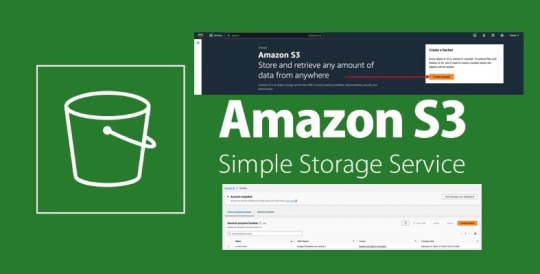
View On WordPress
#Amazon S3#Amazon S3 bucket#Amazon S3 buckets#AWS s3#AWS S3 Bucket#Backup Repository#Object Storage#s3#S3 Bucket#S3 bucket policy#S3 Objects
0 notes
Text
Journey to AWS Proficiency: Unveiling Core Services and Certification Paths
Amazon Web Services, often referred to as AWS, stands at the forefront of cloud technology and has revolutionized the way businesses and individuals leverage the power of the cloud. This blog serves as your comprehensive guide to understanding AWS, exploring its core services, and learning how to master this dynamic platform. From the fundamentals of cloud computing to the hands-on experience of AWS services, we'll cover it all. Additionally, we'll discuss the role of education and training, specifically highlighting the value of ACTE Technologies in nurturing your AWS skills, concluding with a mention of their AWS courses.

The Journey to AWS Proficiency:
1. Basics of Cloud Computing:
Getting Started: Before diving into AWS, it's crucial to understand the fundamentals of cloud computing. Begin by exploring the three primary service models: Infrastructure as a Service (IaaS), Platform as a Service (PaaS), and Software as a Service (SaaS). Gain a clear understanding of what cloud computing is and how it's transforming the IT landscape.
Key Concepts: Delve into the key concepts and advantages of cloud computing, such as scalability, flexibility, cost-effectiveness, and disaster recovery. Simultaneously, explore the potential challenges and drawbacks to get a comprehensive view of cloud technology.
2. AWS Core Services:
Elastic Compute Cloud (EC2): Start your AWS journey with Amazon EC2, which provides resizable compute capacity in the cloud. Learn how to create virtual servers, known as instances, and configure them to your specifications. Gain an understanding of the different instance types and how to deploy applications on EC2.
Simple Storage Service (S3): Explore Amazon S3, a secure and scalable storage service. Discover how to create buckets to store data and objects, configure permissions, and access data using a web interface or APIs.
Relational Database Service (RDS): Understand the importance of databases in cloud applications. Amazon RDS simplifies database management and maintenance. Learn how to set up, manage, and optimize RDS instances for your applications. Dive into database engines like MySQL, PostgreSQL, and more.
3. AWS Certification:
Certification Paths: AWS offers a range of certifications for cloud professionals, from foundational to professional levels. Consider enrolling in certification courses to validate your knowledge and expertise in AWS. AWS Certified Cloud Practitioner, AWS Certified Solutions Architect, and AWS Certified DevOps Engineer are some of the popular certifications to pursue.
Preparation: To prepare for AWS certifications, explore recommended study materials, practice exams, and official AWS training. ACTE Technologies, a reputable training institution, offers AWS certification training programs that can boost your confidence and readiness for the exams.
4. Hands-on Experience:
AWS Free Tier: Register for an AWS account and take advantage of the AWS Free Tier, which offers limited free access to various AWS services for 12 months. Practice creating instances, setting up S3 buckets, and exploring other services within the free tier. This hands-on experience is invaluable in gaining practical skills.
5. Online Courses and Tutorials:
Learning Platforms: Explore online learning platforms like Coursera, edX, Udemy, and LinkedIn Learning. These platforms offer a wide range of AWS courses taught by industry experts. They cover various AWS services, architecture, security, and best practices.
Official AWS Resources: AWS provides extensive online documentation, whitepapers, and tutorials. Their website is a goldmine of information for those looking to learn more about specific AWS services and how to use them effectively.
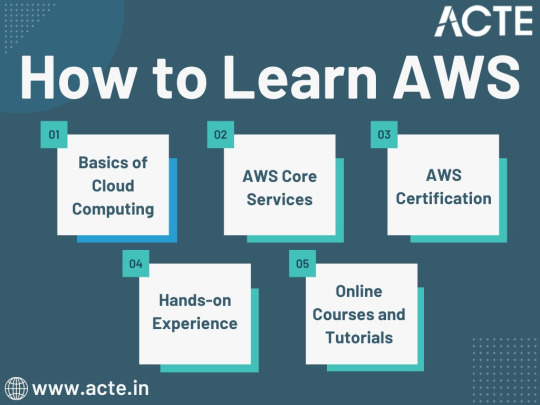
Amazon Web Services (AWS) represents an exciting frontier in the realm of cloud computing. As businesses and individuals increasingly rely on the cloud for innovation and scalability, AWS stands as a pivotal platform. The journey to AWS proficiency involves grasping fundamental cloud concepts, exploring core services, obtaining certifications, and acquiring practical experience. To expedite this process, online courses, tutorials, and structured training from renowned institutions like ACTE Technologies can be invaluable. ACTE Technologies' comprehensive AWS training programs provide hands-on experience, making your quest to master AWS more efficient and positioning you for a successful career in cloud technology.
8 notes
·
View notes
Text
AWS Solutions Architect Certification Journey: A Comprehensive Guide
Embarking on the path to becoming an AWS Certified Solutions Architect - Associate requires a meticulous and strategic approach. This extensive guide offers a step-by-step breakdown of essential steps to ensure effective preparation for this esteemed certification.

1. Grasp Exam Objectives: Initiate your preparation by thoroughly reviewing the official AWS Certified Solutions Architect - Associate exam guide. This roadmap outlines the key domains, concepts, and skills to be evaluated during the exam. A clear understanding of these objectives sets the tone for a focused and effective study plan.
2. Establish a Solid AWS Foundation: Build a robust understanding of core AWS services, infrastructure, and shared responsibility models. Dive into online courses, AWS documentation, and insightful whitepapers. Gain proficiency in essential services such as compute, storage, databases, and networking, laying the groundwork for success.
3. Hands-On Practicality: While theoretical knowledge is crucial, practical experience is where comprehension truly flourishes. Leverage the AWS Free Tier to engage in hands-on exercises. Execute tasks like instance management, security group configuration, S3 bucket setup, and application deployment. Practical experience not only reinforces theoretical knowledge but also provides valuable real-world insights.
4. Enroll in Online Learning Platforms: Capitalize on reputable online courses designed specifically for AWS Certified Solutions Architect preparation. Platforms like A Cloud Guru, Coursera, or the official AWS Training provide structured content, hands-on labs, and practice exams. These courses offer a guided learning path aligned with certification objectives, ensuring a comprehensive and effective preparation experience.
5. Delve into AWS Whitepapers: Uncover a wealth of knowledge in AWS whitepapers and documentation. Explore documents such as the Well-Architected Framework, AWS Best Practices, and Security Best Practices. These resources offer deep insights into architecting on AWS and come highly recommended in the official exam guide.

6. Embrace Practice Exam Simulators: Evaluate your knowledge and readiness through practice exams and simulators available on platforms like Whizlabs, Tutorials Dojo, or the official AWS practice exam. Simulated exam environments not only familiarize you with the exam format but also pinpoint areas that may require additional review.
7. Engage in AWS Communities: Immerse yourself in the AWS community. Participate in forums, discussion groups, and social media channels. Share experiences, seek advice, and learn from the collective wisdom of the community. This engagement provides valuable insights into real-world scenarios and enriches your overall preparation.
8. Regularly Review and Reinforce: Periodically revisit key concepts and domains. Reinforce your understanding through diverse methods like flashcards, summarization, or teaching concepts to others. An iterative review process ensures that knowledge is retained and solidified.
9. Effective Time Management: Develop a well-structured study schedule aligned with your commitments. Prioritize topics based on their weight in the exam guide and allocate ample time for hands-on practice. Efficient time management ensures a balanced and thorough preparation journey.
10. Final Preparation and Confidence Boost: As the exam approaches, conduct a final review of key concepts. Revisit practice exams to bolster confidence and ensure familiarity with the exam interface. Confirm your ease in navigating the AWS Management Console and understanding the exam format.
In conclusion, the journey to mastering AWS Certified Solutions Architect - Associate requires strategic planning and dedicated effort. Success is not merely about passing an exam but about acquiring practical skills applicable in real-world scenarios. Approach this preparation journey with commitment, practical engagement, and a mindset of continuous learning within the ever-evolving AWS ecosystem. By navigating this dynamic landscape, you are not just preparing for a certification; you are laying the foundation for a successful career as an AWS Solutions Architect.
2 notes
·
View notes
Text
Essential AWS Services for Cloud Architects – A Comprehensive Guide
Demand for Cloud Architects in the IT Industry
The demand for cloud architects has surged as businesses increasingly adopt cloud computing to drive innovation, scalability, and cost-efficiency. Organizations across industries—finance, healthcare, e-commerce, and more—are migrating their infrastructure to cloud platforms like AWS, Azure, and Google Cloud. This shift has created a critical need for professionals who can design secure, scalable, and reliable cloud solutions.

Cloud architects bridge the gap between business requirements and technical solutions, ensuring optimal use of cloud services. With the rise of remote work, data security concerns, and the need for digital transformation, skilled cloud architects are more valuable than ever.
Certifications like the AWS Certified Solutions Architect – Associate have become key credentials, validating expertise and opening doors to high-paying roles. As cloud adoption continues to grow, so does the opportunity for cloud professionals to shape the future of IT.
Take AWS Free Digital Training & AWS Skill Builder – Key Points
Beginner to Advanced: Courses cover all levels, including foundational, associate, professional, and specialty topics.
Certification Prep: Includes learning plans specifically for certifications like Solutions Architect – Associate (SAA-C03).
Self-Paced Learning: Learn at your own speed with flexible, on-demand modules.
Hands-On Labs: Interactive labs let you practice real AWS scenarios in a sandbox environment.
Learning Plans: Structured paths guide you step-by-step through skills needed for various roles.
Skill-Based Courses: Topics include compute, storage, security, architecture, DevOps, and more.
Language Support: Many courses available in multiple languages.
Free Tier Friendly: Integrates well with AWS Free Tier for hands-on practice.
Trusted Source: Directly from AWS – accurate, updated, and aligned with exam blueprints.
Choosing Appropriate AWS Services for Solutions
Selecting the right AWS services is a critical skill for building efficient, secure, and scalable cloud solutions. With over 200 services available, AWS offers tools for every use case—from computing and storage to AI, analytics, and networking. The key lies in understanding the problem requirements and mapping them to suitable AWS offerings.
For instance, Amazon EC2 is ideal for flexible virtual servers, while AWS Lambda fits event-driven, serverless workloads. Amazon S3 is perfect for scalable object storage, whereas Amazon RDS simplifies managed database solutions. Security, performance, cost, and scalability must be considered in every decision.
AWS Certified Solutions Architects are trained to evaluate trade-offs and design optimal architectures by leveraging the right mix of services. Making smart service choices leads to resilient systems, lower costs, and improved performance, making this a vital skill in any cloud professional’s toolkit.
Enhances Understanding of AWS Core Services – Key Points
Comprehensive Knowledge: Covers foundational AWS services such as EC2, S3, RDS, VPC, IAM, and Lambda.
Service Categories: Helps understand core categories—compute, storage, networking, databases, and security.
Real-World Application: Learn how services integrate to build end-to-end cloud solutions.
Use-Case Mapping: Trains you to choose the right service based on performance, cost, and scalability needs.
Security Awareness: Builds understanding of AWS Identity and Access Management (IAM), encryption, and compliance features.
Architecture Design: Learn to design scalable, reliable, and fault-tolerant systems using the right AWS tools.
Monitoring & Optimization: Introduces tools like CloudWatch and Trusted Advisor for managing performance and cost.
Preparation for Advanced Roles: Lays the foundation for advanced certifications and roles in cloud architecture and DevOps.
Hands-On Skills: Encourages practice using the AWS Free Tier to explore services directly.
Confidence in Cloud Discussions: Boosts your ability to communicate cloud solutions with technical and non-technical stakeholders.
Keep Learning - AWS Solution Architect Associates.
0 notes
Text
Cloud Computing Market Size, Share, Analysis, Forecast, and Growth Trends to 2032: Fintech and Cloud Integration Reshape Banking
Cloud Computing Market was valued at USD 605.3 billion in 2023 and is expected to reach USD 2619.2 billion by 2032, growing at a CAGR of 17.7% from 2024-2032.
Cloud Computing Market is witnessing unprecedented growth as businesses across the USA continue to shift their operations to flexible, scalable, and cost-efficient digital infrastructures. Accelerated by hybrid work models, rising data demands, and evolving enterprise needs, cloud adoption is becoming central to digital transformation strategies across industries such as healthcare, finance, retail, and manufacturing.
Rapid Digital Transformation Fuels Growth in U.S. Cloud Computing Sector
U.S. Cloud Computing Market was valued at USD 178.66 billion in 2023 and is expected to reach USD 677.09 billion by 2032, growing at a CAGR of 15.95% from 2024-2032.
Cloud Computing Market is being propelled by demand for agility, real-time collaboration, and secure data management. U.S. enterprises are increasingly turning to cloud-native solutions to support AI, machine learning, and big data analytics while optimizing IT resources. This shift is enabling companies to reduce overhead, increase resilience, and innovate faster in competitive environments.
Get Sample Copy of This Report: https://www.snsinsider.com/sample-request/2779
Market Keyplayers:
Amazon Web Services (AWS) (EC2, S3)
Microsoft (Azure Virtual Machines, Azure Storage)
Google Cloud (Google Compute Engine, Google Kubernetes Engine)
IBM (IBM Cloud Private, IBM Cloud Kubernetes Service)
Oracle (Oracle Cloud Infrastructure, Oracle Autonomous Database)
Alibaba Cloud (Elastic Compute Service, Object Storage Service)
Salesforce (Salesforce Sales Cloud, Salesforce Service Cloud)
SAP (SAP HANA Enterprise Cloud, SAP Business Technology Platform)
VMware (VMware vCloud, VMware Cloud on AWS)
Rackspace (Rackspace Cloud Servers, Rackspace Cloud Files)
Dell Technologies (VMware Cloud Foundation, Virtustream Enterprise Cloud)
Hewlett Packard Enterprise (HPE) (HPE GreenLake, HPE Helion)
Tencent Cloud (Tencent Cloud Compute, Tencent Cloud Object Storage)
Adobe (Adobe Creative Cloud, Adobe Document Cloud)
Red Hat (OpenShift, Red Hat Cloud Infrastructure)
Cisco Systems (Cisco Webex Cloud, Cisco Intersight)
Fujitsu (Fujitsu Cloud Service K5, Fujitsu Cloud IaaS Trusted Public S5)
Huawei (Huawei Cloud ECS, Huawei Cloud OBS)
Workday (Workday Human Capital Management, Workday Financial Management)
Market Analysis
The U.S. cloud computing landscape is dominated by major public cloud providers but continues to see rising interest in hybrid and multi-cloud models. The market is shaped by the need for enterprise scalability, security, and compliance with evolving federal data regulations. Growth is also influenced by increasing adoption of edge computing and the expansion of cloud services beyond storage into areas like SaaS, PaaS, and IaaS.
Surge in demand for data-driven decision-making
Expansion of digital-first business models
Growing investments in cloud security and compliance
Migration of legacy systems to modern cloud frameworks
Government and public sector embracing secure cloud infrastructure
Market Trends
Accelerated growth of hybrid and multi-cloud adoption
Edge computing gaining momentum for low-latency applications
Rise in cloud-native application development and containerization
Integration of AI and machine learning into cloud platforms
Increasing demand for zero-trust security architecture
Green cloud initiatives aimed at sustainability
Cloud-as-a-Service models driving operational flexibility
Market Scope
The Cloud Computing Market in the USA spans a wide spectrum of industries and service models, with expanding potential in both enterprise and SMB segments. Its adaptability and real-time innovation capabilities make it a core pillar of modern IT strategy.
Cloud-first strategies across public and private sectors
Rapid adoption in healthcare, finance, and education
API-driven service expansion and integration
On-demand scalability for digital product launches
High ROI for cloud migration and automation projects
Strong potential in disaster recovery and remote operations
Enhanced collaboration tools supporting distributed teams
Forecast Outlook
The outlook for the U.S. Cloud Computing Market remains highly optimistic, fueled by ongoing digital transformation and innovation. As organizations prioritize business continuity, data agility, and customer experience, cloud platforms will remain the foundation of enterprise technology. Expect continued evolution through AI-enhanced services, quantum-safe security, and industry-specific cloud solutions tailored for performance and compliance. The momentum points toward an increasingly intelligent and interconnected cloud ecosystem reshaping how U.S. businesses operate.
Access Complete Report: https://www.snsinsider.com/reports/cloud-computing-market-2779
Conclusion
In today’s fast-paced digital economy, the Cloud Computing Market is not just a trend—it’s the infrastructure of innovation. U.S. companies that harness its full potential are not only future-proofing operations but redefining how they deliver value. As agility, speed, and security become non-negotiable, cloud computing stands out as the strategic engine powering competitive advantage and sustainable growth.
Related reports:
Explore the growth of the healthcare cloud computing market in the US
Analyze trends shaping the microserver industry in the United States
About Us:
SNS Insider is one of the leading market research and consulting agencies that dominates the market research industry globally. Our company's aim is to give clients the knowledge they require in order to function in changing circumstances. In order to give you current, accurate market data, consumer insights, and opinions so that you can make decisions with confidence, we employ a variety of techniques, including surveys, video talks, and focus groups around the world.
Contact Us:
Jagney Dave - Vice President of Client Engagement
Phone: +1-315 636 4242 (US) | +44- 20 3290 5010 (UK)
0 notes